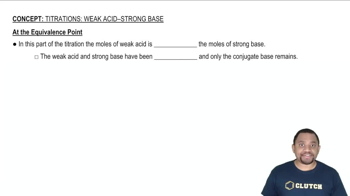Consider the titration of a 35.0-mL sample of 0.175 M HBr with 0.200 M KOH. Determine each quantity. d. the pH at the equivalence point
Consider the titration of a 25.0-mL sample of 0.115 M RbOH with 0.100 M HCl. Determine each quantity. a. the initial pH d. the pH at the equivalence point e. the pH after adding 5.0 mL of acid beyond the equivalence point
 Verified step by step guidance
Verified step by step guidanceKey Concepts
Titration

pH and pH Scale

Equivalence Point

Consider the titration of a 35.0-mL sample of 0.175 M HBr with 0.200 M KOH. Determine each quantity. e. the pH after adding 5.0 mL of base beyond the equivalence point
A 20.0-mL sample of 0.125 M HNO3 is titrated with 0.150 M NaOH. Calculate the pH for at least five different points throughout the titration curve and sketch the curve. Indicate the volume at the equivalence point on your graph.
Consider the titration of a 25.0-mL sample of 0.115 M RbOH with 0.100 M HCl. Determine each quantity. b. the volume of added acid required to reach the equivalence point
Consider the titration of a 25.0-mL sample of 0.115 M RbOH with 0.100 M HCl. Determine each quantity. c. the pH at 5.0 mL of added acid
Consider the titration of a 20.0-mL sample of 0.105 M HC2H3O2 with 0.125 M NaOH. Determine each quantity. b. the volume of added base required to reach the equivalence point
